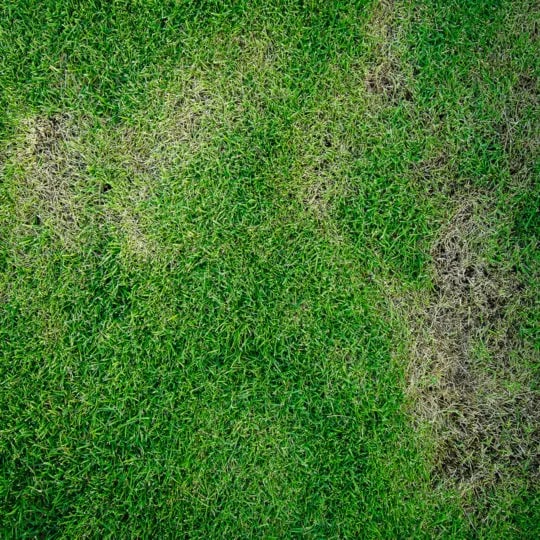Lawn Disease Library
Pythium Blight

Scientific Name: Pythium aphanidermatum, Pythium spp.
Common Names: Cottony blight, grease spot
Primary Grass Affected: Perennial Ryegrass, Creeping Bentgrass
Brief Description: Dark patches of grass ½ an inch to 4 inches in diameter, greasy-looking and grayish (cotton-colored) when wet and yellowish after drying, sometimes growing together to form long streaks and often following the path of water drainage on the lawn.
What is Pythium Blight?
There are over 20 species of fungus that result in Pythium blight, the most common being Pythium aphanidermatum. Pythium blight’s fungal spores can be easily transported by wind, water and by mowing the lawn. For this reason, they are often found growing in lines that follow indents in the lawn where water drainage occurs, or the mowing pattern on the lawn.
Mycelium, or the gray mold created by the fungus Pythium aphanidermatum, is capable of surviving in soil and dead or cut grass blades. It can generate new spores and infect new plants within 2 hours of the arrival of sufficiently warm, damp weather conditions.
Signs and Symptoms of Pythium Blight
Pythium blight starts off looking more or less normal, like dark, damp patches of grass running along already damp areas of the lawn. The wet or “greasy” patches may then develop gray mold. After the infected grass dries and the disease becomes less visible, yellow patches in the same shapes as the former “greasy” patches are left behind.
While Pythium aphanidermatum forms the gray mycelium or fruiting bodies that give the “cottony blight” variety of Pythium blight its name, Pythium spp. does not. Both Pythium aphanidermatum and Pythium spp. are damaging to the roots and crowns of grass, which can, if left untreated, end up killing off patches of grass “permanently” (until new grass seeds germinate in the infected area).
How to Prevent Pythium Blight
Overfertilization and overwatering can often be blamed for the appearance of Pythium blight. Pythium thrives in densely growing, lush grass, and prefers the permanently damp conditions provided by lawns whose soil drain poorly. Fertilizing and watering sparingly (watering once a week at long intervals is preferable), and aerating the soil to prevent the buildup of thatch and loosen compacted soil is recommended.
During long summers, fungicides may be required to get rid of Pythium blight. Fungicides should be applied to Pythium blight when the grass is in the “greasy,” dark green stage of infection.
Need Help with Pythium Blight?
Call today at and let's talk about how we can help you with Pythium Blight and other Lawn Disease Library.